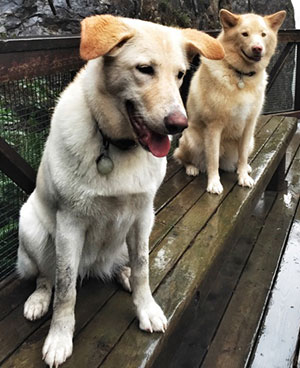
VIN News Service photo
Trupanion CEO Darryl Rawlings founded the company in 2000 in Canada under the name Vetinsurance. The operation expanded to the United States in 2008 and became publicly traded in 2014. Before his involvement in insurance, Rawlings started a business in cigar imports. He also worked in mobile-communications and encryption-technology sales.
When veterinarians got wind that Trupanion, an up-and-coming pet insurer, set premiums based in part on what specific animal hospital a pet owner used, dismay and stress broke out.
“Is it good if you are the cheapest Trupanion clinic? Or the most expensive? … By default, they are going to piss off half the clinics promoting them,” said Dr. Chris Booth, a veterinarian in West Vancouver, B.C. Booth learned about the practice from a pet owner and posted about it on the Veterinary Information Network, an online community for the profession.
Booth, who had recommended Trupanion to his clients for years, was right that the news wouldn’t go over well. It did not, especially after veterinarians heard that his client was quoted lower rates if she were to use other clinics in the vicinity.
“Is this not a form of price control on your clinic by an insurance company?” wondered Dr. Linda Beisswenger, a veterinarian in Missouri.
Dr. Chiara Switzer, a relief veterinarian in Ontario, exclaimed, “The lesson I've learned is that there are more reasons to avoid recommending (third-party) pet insurance than I had previously thought!”
For a company that relies heavily on the goodwill and good word of veterinarians, the negative reaction raised alarms. In January, three months after the complaints arose, Trupanion renounced the practice.
Dr. Steve Weinrauch, Trupanion’s chief veterinary officer, apologized in a post on VIN. “Although our intentions were pure, our hospital-factor approach was both poorly executed and communicated, and fell below our own standards,” his statement read. As a result of a “comprehensive internal review,” he said, “we are going to phase out and ultimately withdraw the current approach.”
In an interview this month at company headquarters in Seattle, Weinrauch and Trupanion founder and CEO Darryl Rawlings told the VIN News Service that using a “hospital factor” was part of an overall effort to set rates fairly by considering the many variables that influence the number and size of claim payouts. The approach was never intended to direct policyholders toward or away from particular practices, Rawlings said.
To the extent that Booth thought this was the case, his response was “Completely valid,” Rawlings said. “If I heard [what he heard], I’d think, ‘This company sucks. They’re trying to steer customers to another place.’ ”
Trupanion’s goal was something quite different, Rawlings said, and one it will continue to pursue. “Fundamentally, what we were trying to accomplish I think is the right thing to do: Share risks fairly.”

Photo by Alexandra Sherron
Riley and Mika belong to Alexandra Sherron, a Trupanion policyholder in West Vancouver, B.C. Sherron's effort to buy veterinary insurance for Riley when she adopted her last fall brought to light Trupanion's use of a "hospital factor" in setting rates.
That strategy wasn’t at all clear to Alexandra Sherron, the pet owner whose experience drew the spotlight to Trupanion’s rate-setting formula.
Sherron had a Trupanion policy on her 6-year-old husky cross, Mika, when she called the insurer in September for a price on covering a new puppy. Sherron was considering a purebred Labrador retriever or another husky mix.
The quote was $167 a month for a Lab and $118 a month for a husky mix. “That made the decision really easy,” Sherron said.
She adopted the husky mix and called Trupanion on Oct. 1, about three weeks later, to start coverage on the new pup, Riley. She was startled to hear that the monthly premium would be $144.50 — amounting to $318 per year more than the original quote.
Sherron asked to speak to a supervisor, but got nowhere. “She said prices sometimes increase and there was nothing she could do.”
Frustrated, Sherron decided to buy insurance elsewhere, and wrote about the experience with Trupanion on Facebook and Yelp.
Shortly after, a Trupanion sales manager called to explain that the rate difference was related to the animal hospital where Sherron takes her dogs. The hospital is well-outfitted with diagnostic equipment such as digital radiography, ultrasound, video otoscopes, an in-house laboratory and other tools and services associated with hospitals serving a high-income demographic.
Intrigued, Sherron asked what the rate would be if she went to either of two other clinics in West Vancouver, or to a clinic in neighboring North Vancouver. In all cases, she was told, the premium would be as originally quoted — that is, lower.
“It became a decision of getting a lower insurance rate or staying with the vet,” Sherron said. “I didn’t think it was fair because I felt like Dr. Booth did such a good job. He was such a good vet. ... You’re getting better health care, and you’re getting punished [with higher rates].”
Sherron opted to stick with Booth. She told him what happened. “I thought he should check out what was happening from his side because maybe he didn’t have the equipment any more that was making him have a higher rate. … It’s not like Dr. Booth is some crazy-big emergency animal hospital,” she added. “He’s just a regular vet.”
A few weeks later, Sherron got another call from Trupanion. This time, the person on the line was the CEO, Rawlings.
“We had a lovely chat,” Sherron reported. Rawlings told her that he was looking into why her quote changed. She informed him that she’d purchased insurance from a competitor. They discussed the difference in rates and differences in coverage. Rawlings offered to honor Trupanion’s original quote. Sherron found him persuasive.
“I made the decision to add our new dog to our existing policy with Trupanion,” she concluded. What’s more, now she’s a devoted fan. “I love the coverage we get with Trupanion and I love our vet, Dr. Booth!” she said.
Factor uncommon; possibly unique

VIN News Service photo
Dr. Steve Weinrauch, Trupanion chief veterinary officer, encourages practitioners to reach out with questions, comments, concerns and criticisms. “How do we let vets know we’re human, and that I’m their classmate?” he said. “Let’s talk to each other.”
Rawlings told the VIN News Service that Sherron’s was an unusual case because after she obtained the first quote, her veterinarian gave her a promotional certificate for 30 days' free coverage. The certificate linked her to Booth’s practice.
“If this client had enrolled online or on the telephone without the certificate, she would have gotten the original quote,” Rawlings said.
At the time of the quote, Sherron already was a Trupanion customer, and her dog, Mika, a patient of Booth’s. However, Rawlings said, “our quoting mechanism doesn’t check people’s [existing] policy.”
The company would have adjusted the premium later, he said, once it became aware where she was receiving veterinary services for Riley.
While companies selling insurance of all kinds commonly base rates in part upon the customer’s geographic location, Trupanion may have been unique among pet insurers in the United States and Canada — where 14 companies sell more than 20 brands — in using a hospital factor.
At Nationwide, rates are determined by plan type, age of pet, species and size of breed as an adult, and the policyholder’s state of residence, according to Dr. Carol McConnell, vice president and chief veterinary medical officer. “The animal hospital has no bearing on the rate,” McConnell said by email. Nationwide is the largest pet insurer in the United States, and was the first, founded in 1980 under the name Veterinary Pet Insurance.
At another insurer, Petplan, the chief medical veterinary officer likewise said its premiums are based on the level of coverage chosen by the policyholder, the pet’s age and breed and residential ZIP code.
“Petplan North America does not (and has never) allowed the policyholder’s choice of veterinarian or veterinary hospital to affect the premium paid for their policy,” Dr. Jules Benson said by email. “… It is our belief that policyholders should have the freedom to seek veterinary care with any properly licensed veterinary professional without being penalized for that choice.”
Two veterinarians who follow the pet insurance industry closely — Dr. Frances Wilkerson, creator of an online guide called Pet Insurance University, and Dr. Doug Kenney, who writes a blog on the subject — said Trupanion’s use of the hospital factor was the first they’d heard of it.
“I know some pet insurance companies will watch for hospitals that charge more than others in their area, but I don’t think they’re [doing] it to set premium rates higher for those hospitals,” Wilkerson said. “If a hospital charges more than the average for the area, those pet insurance companies will just reimburse up to the average for the area.”
At Trupanion, Weinrauch’s initial responses to questions about the hospital factor suggested that the company had used it for years systemwide. Trupanion had 272,636 dogs and cats enrolled for coverage as of Dec. 31, according to its Form 10-K, an annual report to the Securities and Exchange Commission.
Asked whether the factor led any customers to change veterinary clinics in order to lower their premiums, Weinrauch replied: “We have well over a quarter-million active policies. In my nearly two years with Trupanion, I am aware of only two clients who managed to pull vets or Trupanion team members down a rabbit hole in this regard. To my knowledge, both stayed with their vet.”
Weinrauch later clarified that the hospital factor was in use for about two years in 60 test hospitals only, and that elsewhere, the company accounted for geographic differences in wealth using ZIP codes and postal codes. Rawlings said a policyholder obtaining veterinary care from a hospital outside of where she lived would be charged as if she lived near the hospital. For example, someone taking her pet to a veterinarian in Beverly Hills would be charged Beverly Hills rates even if she lived in a humbler neighborhood.
Like all insurers in the United States, Trupanion is subject to regulation by the states. Where required, the company had submitted its use of a hospital factor for approval. To remove the hospital factor from all policies, the company will need written approval in those states, Rawlings said.
North of the border, the process is different. “In Canada, we can move faster,” Rawlings said. There, the hospital factor is “gone,” he said.
From a practical standpoint, if not formally, Rawlings said this week, the hospital factor no longer is in play anywhere.
Factor may reappear in new form
That’s not to say Trupanion has abandoned the concept of factoring hospitals’ charging patterns into its rates.
“We don’t want to have a [situation] where a customer … potentially [changes] their behavior on which hospital they’re going to, so we’re going to remove it until we can get something right,” Rawlings said. “The concept of being fair is something we’re still [pursuing].”
He added, “When we try it again, we’ll do it in a slightly better way. It’ll probably happen in a small test area [first].”
Getting it right is apt to be a delicate operation. Wilkerson, creator of the Pet Insurance University website, worries that by using a hospital factor, a company could manipulate independent practitioners to adjust their fees to suit the insurer.
“We start to creep into managed care with the hospital factor,” Wilkerson said. “It can be used in ways that, in my opinion, can harm the profession.”
Booth, the veterinarian whose practice was judged by Trupanion to be more expensive than average, said he understands why the company would want to charge policyholders more for taking their pets to practices that provide higher-end services. “I totally get it,” he said.
But Booth finds the method fraught. “If Trupanion tells clients who is cheaper (or by default, people find out), then all vet practices have to get rid of ultrasound and digital radiography X-ray, and go to the lowest common denominator to compete.”
Beyond his concern about implications of a hospital factor, Booth is disappointed that it was difficult to get a straight story from Trupanion. When he brought the news about the hospital factor to colleagues on VIN, several veterinarians then contacted their Trupanion sales representatives asking if it were true. They were told it was not.
“I guess it’s business,” he said glumly. “You deny wrongdoing until someone holds your feet to the fire, and then you say it was an accident. If you didn’t tell your sales reps,” he added, “that says it’s not something you think is a good thing. … I’m disappointed because even though they did the right thing, they didn’t do it until they got called out.”
Weinrauch said the company tried to be responsive to the criticism. “We figured it out and we did something about it,” he said. “It seems like there’s egg on our face. Maybe there is. We’re not perfect.”
Despite Booth’s disillusionment, he has no hard feelings toward the company. In fact, he has a Trupanion policy on his own dog. Booth said he’s liked Trupanion’s approach for being fairly straightforward, providing 90 percent coverage of eligible services and medications, with no cap on benefits, unlike many insurance plans.
Trupanion’s business strategy depends upon maintaining good relationships with veterinarians.
The company states in its 10-K report: “Veterinary practices represent our largest referral source. Forming long-term relationships with veterinarians is critical to our continued success, as we believe veterinary recommendations are highly persuasive to our existing and prospective members and key to increasing overall acceptance of our medical plan.”
Kenney, the pet-insurance blogger, said the industry, which is still trying to gain a foothold in North America, tends to be responsive to veterinarians’ concerns.
“I’ve found the pet insurance companies are pretty receptive to what veterinarians think and the fears they have about pet insurance,” Kenney said. “… I believe that they are receptive to opinions, and when things don’t work out the way they had intended, they’re willing to listen and change the policy.”
He added: “As long as we communicate with one another and we’re willing to communicate with the pet insurance companies involved or the pet insurance industry as whole, I think we can make sure that any concerns that the veterinary profession has are addressed, and maybe have a hand in how this industry evolves.”